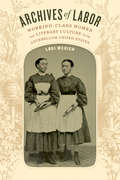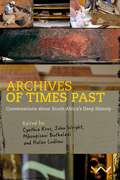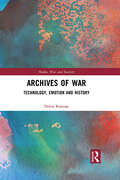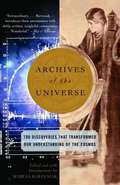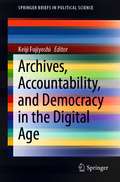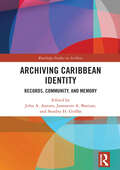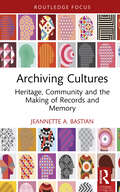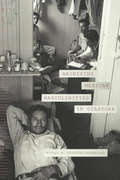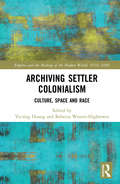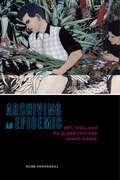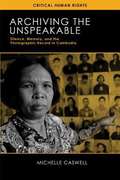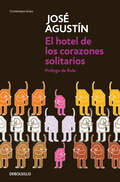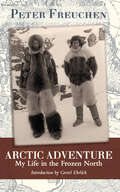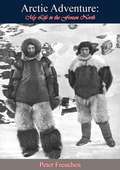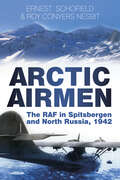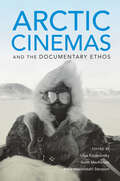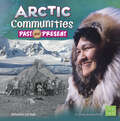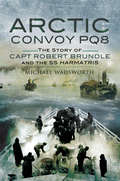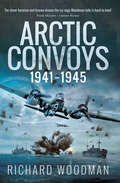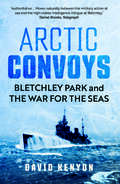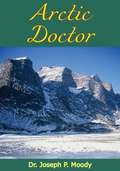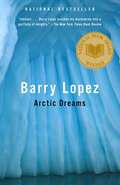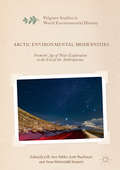- Table View
- List View
Archives of Infamy: Foucault on State Power in the Lives of Ordinary Citizens
by Michel Foucault Lynne Huffer Arlette Farge Stuart Elden Roger Chartier Pierre Nora Jean-Philippe Guinle Michel Heurteaux Michael Rey Elizabeth WingroveExpanding the insights of Arlette Farge and Michel Foucault&’s Disorderly Families into policing, public order, (in)justice, and daily life What might it mean for ordinary people to intervene in the circulation of power between police and the streets, sovereigns and their subjects? How did the police come to understand themselves as responsible for the circulation of people as much as things—and to separate law and justice from the maintenance of a newly emergent civil order? These are among the many questions addressed in the interpretive essays in Archives of Infamy.Crisscrossing the Atlantic to bring together unpublished radio broadcasts, book reviews, and essays by historians, geographers, and political theorists, Archives of Infamy provides historical and archival contexts to the recent translation of Disorderly Families by Arlette Farge and Michel Foucault. This volume includes new translations of key texts, including a radio address Foucault gave in 1983 that explains the writing process for Disorderly Families; two essays by Foucault not readily available in English; and a previously untranslated essay by Farge that describes how historians have appropriated Foucault.Archives of Infamy pushes past old debates between philosophers and historians to offer a new perspective on the crystallization of ideas—of the family, gender relations, and political power—into social relationships and the regimes of power they engender. Contributors: Roger Chartier, Collège de France; Stuart Elden, U of Warwick; Arlette Farge, Centre national de recherche scientifique; Michel Foucault (1926–1984); Jean-Philippe Guinle, Catholic Institute of Paris; Michel Heurteaux; Pierre Nora, École des Hautes Études en Sciences Sociales; Michael Rey (1953–1993); Thomas Scott-Railton; Elizabeth Wingrove, U of Michigan.
Archives of Labor: Working-Class Women and Literary Culture in the Antebellum United States
by Lori MerishIn Archives of Labor, Lori Merish establishes working-class women as significant actors within literary culture, dramatically redrawing the map of nineteenth-century US literary and cultural history. Delving into previously unexplored archives of working-class women's literature—from autobiographies, pamphlet novels, and theatrical melodrama to seduction tales and labor periodicals—Merish recovers working-class women's vital presence as writers and readers in the antebellum era. Her reading of texts by a diverse collection of factory workers, seamstresses, domestic workers, and prostitutes boldly challenges the purportedly masculine character of class dissent during this era. Whether addressing portrayals of white New England "factory girls," fictional accounts of African American domestic workers, or the first-person narratives of Mexican women working in the missions of Mexican California, Merish unsettles the traditional association of whiteness with the working class to document forms of cross-racial class identification and solidarity. In so doing, she restores the tradition of working women's class protest and dissent, shows how race and gender are central to class identity, and traces the ways working women understood themselves and were understood as workers and class subjects.
Archives of Times Past: Conversations about South Africa’s Deep History
by Rachel King Amanda Esterhuysen Hlonipha Mokoena Mbongiseni Buthelezi Sifiso Mxolisi Ndlovu Cynthia Kros John Wright Helen Ludlow Geoffrey Blundell Jan Boeyens Lize Kriel Sekibakiba Peter Lekgoathi Grant McNulty Fred Morton Muchaparara Musemwa Ndukuyakhe Ndlovu Himal Ramji Justine WintjesThis volume critically examines sources of evidence and material from the archive that historically have been used to tell southern Africa’s pre-colonial story.
Archives of War: Technology, Emotion and History (Media, War and Security)
by Debra RamsayThis book offers a comparative analysis of British Army Unit War Diaries in the two World Wars, to reveal the role played by previously unnoticed technologies in shaping the archival records of war. Despite thriving scholarship on the history of war, the history of Operational Record Keeping in the British Army remains unexplored. Since World War I, the British Army has maintained daily records of its operations. These records, Unit War Diaries, are the first official draft of events on the battlefield. They are vital for the army’s operational effectiveness and fundamental to the histories of British conflict, yet the material history of their own production and development has been widely ignored. This book is the first to consider Unit War Diaries as mediated, material artefacts with their own history. Through a unique comparative analysis of the Unit War Diaries of the First and Second World Wars, this book uncovers the mediated processes involved in the practice of operational reporting and reveals how hidden technologies and ideologies have shaped the official record of warfare. Tracking the records into The National Archives in Kew, where they are now held, the book interrogates how they are re-presented and re-interpreted through the archive. It investigates how the individuals, institutions and technologies involved in the production and uses of unit diaries from battlefield to archive have influenced how modern war is understood and, more importantly, waged. This book will be of much interest to students of media and communication studies, military history, archive studies and British history.
Archives of the Universe: 100 Discoveries that Transformed Our Understanding of the Cosmos
by Marcia BartusiakAn unparalleled history of astronomy presented in the words of the scientists who made the discoveries. Here are the writings of Copernicus, Galileo, Kepler, Newton, Halley, Hubble, and Einstein, as well as that of dozens of others who have significantly contributed to our picture of the universe. From Aristotle's proof that the Earth is round to the 1998 paper that posited an accelerating universe, this book contains 100 entries spanning the history of astronomy. Award-winning science writer Marcia Bartusiak provides enormously entertaining introductions, putting the material in context and explaining its place in the literature. Archives of the Universeis essential reading for professional astronomers, science history buffs, and backyard stargazers alike.
Archives, Accountability, and Democracy in the Digital Age (SpringerBriefs in Political Science)
by Keiji FujiyoshiThis book is the first attempt to introduce the current status of archival practices in Japan as well as the basic views of the populace on making records accessible to English readers. In general, Japan has not paid sufficient attention to keeping and utilizing records except in the field of historical research. This book thus examines Japanese attitudes about history, records management, information acts, the status of archivists of the constitution, and genealogical research practices and a description of archives. Consequently, such investigations clarify how both private and public archives function or fail to do so in those spheres of Japanese society. In addition, this book presents the efforts in wartime record keeping in Australia, which is significantly different from how the Japanese deal with such records. This book therefore provides a clear and concrete picture of the status of current archival practices in Japan and the thinking that underlies them. On the basis of such examinations, this book enables readers to understand to what extent and how the past affects the present through archives, to recognize the importance of archives, and to respect the past in order to maintain and develop perspectives in people’s lives.
Archiving Caribbean Identity: Records, Community, and Memory (Routledge Studies in Archives)
by John A. Aarons Jeannette A. Bastian Stanley H. GriffinArchiving Caribbean Identity highlights the "Caribbeanization" of archives in the region, considering what those archives could include in the future and exploring the potential for new records in new formats. Interpreting records in the broadest sense, the 15 chapters in this volume explore a wide variety of records that represent new archival interpretations. The book is split into two parts, with the first part focusing on record forms that are not generally considered "archival" in traditional Western practice. The second part explores more "traditional" archival collections and demonstrates how these collections are analysed and presented from the perspective of Caribbean peoples. As a whole, the volume suggests how colonial records can be repurposed to surface Caribbean narratives. Reflecting on the unique challenges faced by developing countries as they approach their archives, the volume considers how to identify and archive records in the forms and formats that reflect the postcolonial and decolonized Caribbean, how to build an archive of the people that documents contemporary society and reflects Caribbean memory, and how to repurpose the colonial archives so that they assist the Caribbean in reclaiming its history. Archiving Caribbean Identity demonstrates how non-textual cultural traces function as archival records and how folk-centred perspectives disrupt conventional understandings of records. The book should thus be of interest to academics and students engaged in the study of archives, memory, culture, history, sociology, and the colonial and postcolonial experience.
Archiving Cultures: Heritage, community and the making of records and memory (Routledge Studies in Archives)
by Jeannette A. BastianArchiving Cultures defines and models the concept of cultural archives, focusing on how diverse communities express and record their heritage and collective memory and why and how these often-intangible expressions are archival records. Analysis of oral traditions, memory texts and performance arts demonstrate their relevance as records of their communities. Key features of this book include definitions of cultural heritage and archival heritage with an emphasis on intangible cultural heritage. Aspects of cultural heritage such as oral traditions, performance arts, memory texts and collective memory are placed within the context of records and archives. It presents strategies for reconciling intangible and tangible cultural expressions with traditional archival theory and practice and offers both analog and digital models for constructing cultural archives through examples and vignettes. The audience includes archivists and other information workers who challenge Western archival theory and scholars concerned with interdisciplinary perspectives on tangible and intangible cultural heritage. This book is relevant to scholars involved with non-textual materials and will appeal to a range of academic disciplines engaging with "the archive".
Archiving Medical Violence: Consent and the Carceral State
by Christopher PerreiraA major new reading of a U.S. public health system shaped by fraught perceptions of culture, race, and criminality At the heart of Archiving Medical Violence is an interrogation of the notions of national and scientific progress, marking an advance in scholarship that shows how such violence is both an engine of medical progress and, more broadly, the production of empire. It reads the medical archive through a lens that centers how it is produced, remembered, and contested within cultural production and critical memory. In this innovative and interdisciplinary book, Christopher Perreira argues that it is in the contradictions of settler colonialism and racial capitalism that we find how medical violence is narrated as a public good. He presents case studies from across a range of locations—Hawai&‘i, California, Louisiana, Guatemala—and historical periods from the nineteenth century on. Examining national and scientific conceptions of progress through the lens of medicine and public health, he places official archives in dialogue with visual and literary works, patient writing, and more. Archiving Medical Violence explores the contested public terrains for narrating value and vulnerabilities, bodies and geographical locations. Ultimately, Perreira reveals for us a medical imaginary built on racialized criminality driving contemporary politics of citizenship, memory, and identity. Retail e-book files for this title are screen-reader friendly with images accompanied by short alt text and/or extended descriptions.
Archiving Mexican Masculinities in Diaspora
by Nicole M. Guidotti-HernándezIn Archiving Mexican Masculinities in Diaspora, Nicole M. Guidotti-Hernández challenges machismo—a shorthand for racialized and heteronormative Latinx men's misogyny—with nuanced portraits of Mexican men and masculinities along and across the US-Mexico border. Guidotti-Hernández foregrounds Mexican men's emotional vulnerabilities and intimacies in their diasporic communities. Highlighting how Enrique Flores Magón, an anarchist political leader and journalist, upended gender norms through sentimentality and emotional vulnerability that he performed publicly and expressed privately, Guidotti-Hernández documents compelling continuities between his expressions and those of men enrolled in the Bracero program. Braceros—more than 4.5 million Mexican men who traveled to the United States to work in temporary agricultural jobs from 1942 to 1964—forged domesticity and intimacy, sharing affection but also physical violence. Through these case studies that reexamine the diasporic male private sphere, Guidotti-Hernández formulates a theory of transnational Mexican masculinities rooted in emotional and physical intimacy that emerged from the experiences of being racial, political, and social outsiders in the United States.
Archiving Settler Colonialism: Culture, Space and Race (Empires and the Making of the Modern World, 1650-2000)
by Rebecca Weaver-Hightower Yu-Ting HuangArchiving Settler Colonialism: Culture, Race, and Space brings together 15 essays from across the globe, to capture a moment in settler colonial studies that turns increasingly towards new cultural archives for settler colonial research. Essays on hitherto under-examined materials—including postage stamps, musical scores, urban parks, and psychiatric records—reflect on how cultural texts archive moments of settler self-fashioning. Archiving Settler Colonialism also expands settler colonial studies’ reach as an international academic discipline, bringing together scholarly research about the British breakaway settler colonies with underanalyzed non-white, non-Anglophone settler societies. The essays together illustrate settler colonial cultures as—for all their similarities—ultimately divergent constructions, locally situated and produced of specific power relations within the messy operations of imperial domination.
Archiving an Epidemic: Art, AIDS, and the Queer Chicanx Avant-Garde (Sexual Cultures #36)
by Robb HernándezHonorable Mention, 2021 Latinx Studies Section Outstanding Book Award, given by the Latin American Studies AssociationWinner, 2020 Latino Book Awards in the LGBTQ+ Themed SectionFinalist, 2019 Lambda Literary Award in LGBTQ StudiesCritically reimagines Chicanx art, unmasking its queer afterlife Emboldened by the boom in art, fashion, music, and retail culture in 1980s Los Angeles, the iconoclasts of queer Aztlán—as Robb Hernández terms the group of artists who emerged from East LA, Orange County, and other parts of Southern California during this period—developed a new vernacular with which to read the city in bloom. Tracing this important but understudied body of work, Archiving an Epidemic catalogs a queer retelling of the Chicana and Chicano art movement, from its origins in the 1960s, to the AIDS crisis and the destruction it wrought in the 1980s, and onto the remnants and legacies of these artists in the current moment. Hernández offers a vocabulary for this multi-modal avant-garde—one that contests the heteromasculinity and ocular surveillance visited upon it by the larger Chicanx community, as well as the formally straight conditions of traditional archive-building, museum institutions, and the art world writ large. With a focus on works by Mundo Meza (1955–85), Teddy Sandoval (1949–1995), and Joey Terrill (1955– ), and with appearances by Laura Aguilar, David Hockney, Robert Mapplethorpe, and even Eddie Murphy, Archiving an Epidemic composes a complex picture of queer Chicanx avant-gardisms. With over sixty images—many of which are published here for the first time—Hernández’s work excavates this archive to question not what Chicanx art is, but what it could have been.
Archiving the Unspeakable
by Michelle CaswellRoughly 1. 7 million people died in Cambodia from untreated disease, starvation, and execution during the Khmer Rouge reign of less than four years in the late 1970s. The regime’s brutality has come to be symbolized by the multitude of black-and-white mug shots of prisoners taken at the notorious Tuol Sleng prison, where thousands of #147;enemies of the state” were tortured before being sent to the Killing Fields. In Archiving the Unspeakable, Michelle Caswell traces the social life of these photographic records through the lens of archival studies and elucidates how, paradoxically, they have become agents of silence and witnessing, human rights and injustice as they are deployed at various moments in time and space. From their creation as Khmer Rouge administrative records to their transformation beginning in 1979 into museum displays, archival collections, and databases, the mug shots are key components in an ongoing drama of unimaginable human suffering.
Archivo José Agustín: Y otros (muchos) textos sobre rock.
by José Agustín"José Agustín es una de las más notables manifestaciones del rock mexicano, probablemente mucho más potente y más significativa que buena parte de las bandas que han surgido en este país" RULO, tomado del prólogo José Agustín es una de las plumas más potentes de la literatura mexicana, representante de una generación de escritores cuyas letras fueron el instrumento ideal para dar voz a una época marcada por el rock, la psicodelia y el relajo. Este volumen, primero de una serie de textos poco conocidos del autor, reúne crónicas y ensayos de José Agustín. Del blues del Misisipi a las tornamesas de Tijuana, de la melancolía de José Alfredo al cine de Orson Welles, José Agustín explora con su libertad y estilo característicos los derroteros de la música, las letras y, por qué no, del cine para ofrecer al lector un atisbo a su visión personalísima del mundo. El resultado es un libro ecléctico y desmadroso, cuyo eje es la pasión incansable que su autor tiene por la música y la palabra.
Arctic Adventure: My Life in the Frozen North
by Peter FreuchenShortly after his death in 1957, The New York Times obituary of Peter Freuchen noted that "except for Richard E. Byrd, and despite his foreign beginnings, Freuchen was perhaps better known to more people in the United States than any other explorer of our time." During his lifetime Freuchen's remarkable adventures, related in his books, magazine articles, and films, made him a legend. In 1910, Freuchen and his friend and business partner, Knud Rasmussen, the renowned polar explorer, founded Thule-a Greenland Inuit trading post and village only 800 miles from the North Pole. Freuchen lived in Thule for fifteen years, adopting ways of its natives. He married an Inuit woman, and together they had two children. Freuchen went on many expeditions, quite a few of which he barely survived, suffering frostbite, snow blindness, and starvation. Near the North Pole there is no such thing as an easy and safe outing. In Arctic Adventure Freuchen writes of polar bear hunts, of meeting Eskimos who had resorted to cannibalism during a severe famine, and of the thrill of seeing the sun after three months of winter darkness. Trained as a journalist before he headed north, Freuchen is a fine writer and great storyteller (he won an Oscar for his feature film script of Eskimo). He writes about the Inuit with genuine respect and affection, describing their stoicism amidst hardship, their spiritual beliefs, their ingenious methods of surviving their harsh environment, their humor and joy in the face of danger and difficulties, and the social politics behind such customs as "wife-trading." While his experiences make this book a pageturner, Freuchen's warmth, self-deprecating wit, writing skill and anthropological observations make this book a literary stand out.
Arctic Adventure: My Life in the Frozen North (Lyons Press Series)
by Peter FreuchenOriginally published in 1956, this book is a memoir by Danish explorer Peter Freuchen, a close friend and travel companion of Arctic legend Knud Rasmussen, and ended up living in Greenland for fifteen years, 800 miles from the North Pole--adopting the native ways of life, marrying an Inuit woman, and having two children along the way.Arctic Adventure is filled with tales of seal and polar bear hunts, enduring starvation, encountering people who had resorted to cannibalism, and the stirring experience of seeing the sun again after three months of winter darkness.Rich in human saga, Freuchen's warmth, wit, and literary talent make this recollection of real-life adventure stories a stand-out."Except for Richard E. Byrd, and despite his foreign beginnings, Freuchen was perhaps better known to more people in the United States than any other explorer of our time."--Evelyn Stefansson, The New York Times"[A] formidable and fascinating man"--Harriet Baker, AnOtherRichly illustrated throughout with maps and black-and-white photographs.
Arctic Airmen: The RAF in Spitsbergen and North Russia, 1942
by Roy Conyers Nesbit Ernest SchofieldIn 1942 a Catalina crew of 210 Squadron, based at Sullom Voe in the Shetlands, was selected to carry out a series of highly secret operations, including a flight to the North Pole. The sorties were associated with a Norwegian expedition from Britain to Spitsbergen, to deny the use of the territory to the enemy. The flights made by the crew were frequently over twenty-four hours in length and reached the limits of human endurance, in conditions of extreme cold. Later, the squadron was detached to North Russia, to provide cover for the convoys taking vital supplies to the Allies on the Eastern Front. The navigator of the crew, Ernest Schofield, retained logs of most of these sorties. Together with other survivors of the crew, accounts from German sources and research carried out by Roy Conyers Nesbit, he recreated these little-known events, in detailed and accurate narrative that ends in tragedy.
Arctic Cinemas and the Documentary Ethos
by Anna Westerstahl StenportA collection of essays analyzing the representation of the Arctic region in documentary films.Beginning with Robert Flaherty’s Nanook of the North (1922), the majority of films that have been made in, about, and by filmmakers from the Arctic region have been documentary cinema. Focused on a hostile environment that few people visit, these documentaries have heavily shaped ideas about the contemporary global Far North. In Arctic Cinemas and the Documentary Ethos, contributors from a variety of scholarly and artistic backgrounds come together to provide a comprehensive study of Arctic documentary cinemas from a transnational perspective. This book offers a thorough analysis of the concept of the Arctic as it is represented in documentary filmmaking, while challenging the notion of “The Arctic” as a homogenous entity that obscures the environmental, historical, geographic, political, and cultural differences that characterize the region. By examining how the Arctic is imagined, understood, and appropriated in documentary work, the contributors argue that such films are key in contextualizing environmental, indigenous, political, cultural, sociological, and ethnographic understandings of the Arctic, from early cinema to the present. Understanding the role of these films becomes all the more urgent in the present day, as conversations around resource extraction, climate change, and sovereignty take center stage in the Arctic’s representation.“Highly recommended.” —Choice“A thorough exploration of the inexorable links between the circumpolar regions and historic and contemporary documentary filmmaking. It will b valuable to Arctic humanities specialists, particularly as a welcome addition to scholarship on visual depictions of the Arctic by authors such as Ann Fienup-Riordan, Richard Condon, Russell Potter, and Peter Geller, as well as Mackenzie and Westerstahl Steport’s earlier co-edited volume, Films on Ice. It will also be of use to anyone interested in ways of studying linkages between filmmaking, environments, and local and outsider communities.” —Sarah Pickman, Yale University, H-Environment, January 2020
Arctic Communities Past and Present (Who Lived Here?)
by Cindy Jenson-ElliottTo live in the Arctic, people have had to adapt to a freezing climate of ice and snow. Learn how Arctic communities have survived for thousands of years in this harsh environment. Discover how villagers find food in a land with few animals and plants. Examine how these communities are changing in a world of computers and global climate change.
Arctic Convoy PQ8: The Story of Capt Robert Brundle and the SS Harmatris
by Michael WadsworthWhen Robert Brundle took the SS Harmatris to Russia with Convoy PQ8 he was 47 years of age. Both ship and master were veterans and had already sailed in convoys across the North Atlantic and to South Africa. The 5,395 ton coal fired ship, laden with 8,000 tons of armaments originally set sail on 27 November 1941 to join convoy PQ6 but encountered a fierce storm in which a lorry broke free in the hold and started a fierce blaze below decks. Despite valiant attempts to extinguish the fire the Harmatris was forced to return to Glasgow for repair. Having discharged its cargo, examined and repaired the holds, it restowed and finally put to sea again on 26 December. She was now to join PQ8 and Brundle was elected Convoy Commodore. Two minesweepers, a cruiser and two destroyers escorted the eight merchant vessels.On 8 January the convoy left Reykjavik bound for Murmansk. Harmatris was struck by two torpedoes in No 1 hold which caused flooding. A third torpedo struck her a few hours later and the crew evacuated to HMS Speedwell in attendance. A volunteer crew reboarded and Speedwell took the wounded ship in tow. During the night the same U Boat that had struck Harmatris sunk the destroyer Matabele with the loss of all but two of her crew. A tug eventually replaced Speedwell and the entire crew now returned to their still stricken vessel. On 18 January the ships were twice attacked by low flying Heinkels. The stricken Harmatris finally berthed in Murmansk at 0800 on 20 January. Once unloaded the battered ship entered dry dock on 10 February. The damage was considerable. In a temperature of 40 degrees below zero the crew set about the repairs. It was difficult to locate engine parts and local labor was scarce.During the following months the crew continued to work on the ship, food was scarce and the port was frequently bombed by the Luftwaffe. Several ships close to Harmatris were sunk. It was 21 July when the ship finally left for Archangel. She took aboard a cargo of 3,000 tons of steel pipes and on 13 September she was instructed to join a convoy of 20 ships, QP14 for her return voyage. On 19 September the minesweeper HMS Leda, steaming close by Harmartris, was torpedoed. The convoy was under almost continuous U Boat attack and suffered six losses. As a result of his heroic efforts to preserve his ship and crew Captain Brundle was awarded the OBE and the Lloyds War Medal. He died in 1960 at the age of 66.
Arctic Convoys, 1941–1945
by Richard WoodmanThe story of Allied merchant ships and crews who braved the frigid far north to extend a lifeline to Russia, filled with &“sheer heroism and brazen drama&” (Literary Review). During the last four years of the Second World War, the Western Allies secured Russian defenses against Germany by supplying vital food and arms. The plight of those in Murmansk and Archangel who benefited is now well known, but few are aware of the courage, determination, and sacrifice of Allied merchant ships, which withstood unremitting U-boat attacks and aerial bombardment to maintain the lifeline to Russia. In the storms, fog, and numbing cold of the Arctic, where the sinking of a ten thousand–ton freighter was equal to a land battle in terms of destruction, the losses sustained were huge. Told from the perspective of their crews, this is the inspiring story of the long-suffering merchant ships without which Russia would almost certainly have fallen to Nazi Germany.
Arctic Convoys: Bletchley Park and the War for the Seas
by David KenyonAn incisive account of the Arctic convoys, and the essential role Bletchley Park and Special Intelligence played in Allied success Between 1941 and 1945, more than eight hundred shiploads of supplies were delivered to the Soviet Union protected by allied naval forces. Each journey was a battle against the elements, with turbulent seas, extreme cold, and the constant dread of torpedoes. These Arctic convoys have been mythologized as defenseless vessels at the mercy of deadly U-boats—but was this really the case? David Kenyon explores the story of the war in the Arctic, revealing that the contest was more evenly balanced that previously thought. Battles included major ship engagements, aircraft carriers, and combat between surface ships. Amid this wide range of forces, Bletchley Park’s Naval Section played a decisive role in Arctic operations, with both sides relying heavily on Signals Intelligence to intercept and break each other’s codes. Kenyon presents a vivid picture of the Arctic theater of war, unearthing the full-scale campaign for naval supremacy in northern waters.
Arctic Doctor
by Dr Joseph P. MoodyArctic Doctor is an account of the true adventures of Joe Moody, the heroic young medical doctor whose practice covered 600,000 square miles of Canada’s East Arctic. Headquartered at Chesterfield Inlet on the west coast of Hudson Bay, Joe Moody made “routine” calls to his 2,000 Eskimo patients that required to take perilous trips by aircraft, dog sled, and canoe; to direct complicated surgery by telephone; and to confront Eskimo practices of infanticide and the “assisted suicide” of the age.Dr. Moody’s book is an exciting and suspenseful account of his years in the East Arctic—years of courageous effort on behalf of his profession, years devoted to scientific and human observation of the most fruitful kind, and years of heady adventure rarely matched in the annals of northland fiction.
Arctic Dreams: Imagination and Desire in a Northern Landscape
by Barry Holstun LopezThis National Book Award winner examines the Far North - its terrain, wildlife, and history of the Eskimo natives and intrepid explorers who arrived on its icy shores. What turns this compendium of biology, anthropology and history into a breathtaking study of profound originality is Lopez's unique meditation on how the landscape can shape our imagination, desires and dreams.
Arctic Environmental Modernities: From the Age of Polar Exploration to the Era of the Anthropocene (Palgrave Studies in World Environmental History)
by Lill-Ann Körber Anna Westerståhl Stenport Scott MacKenzieThis book offers a diverse and groundbreaking account of the intersections between modernities and environments in the circumpolar global North, foregrounding the Arctic as a critical space of modernity, where the past, present, and future of the planet’s environmental and political systems are projected and imagined. Investigating the Arctic region as a privileged site of modernity, this book articulates the globally significant, but often overlooked, junctures between environmentalism and sustainability, indigenous epistemologies and scientific rhetoric, and decolonization strategies and governmentality. With international expertise made easily accessible, readers can observe and understand the rise and conflicted status of Arctic modernities, from the nineteenth century polar explorer era to the present day of anthropogenic climate change.

